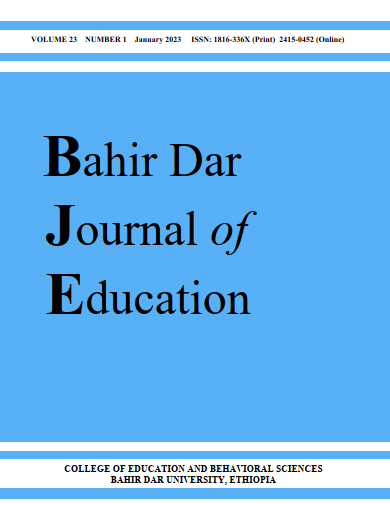Assessment of the COVID-19 Crisis Management in Bahir Dar City Administration Government Secondary Schools as Perceived by Teachers
Abstract
The purpose of the study was to examine the practices of adaptive leadership implemented by secondary school principals during the COVID-19 crisis to mitigate the pandemic's consequences on students' learning. The study employed the correlational design of the quantitative research approach. Data collected from 242 randomly selected teachers using a questionnaire were analyzed using descriptive (mean, standard deviation, one-sample t-test) and inferential statistics, including the Pearson product-moment correlation coefficient and multiple regressions. The findings from the data analyses showed that principals employed adaptive leadership in the schools to manage crises of the COVID-19 pandemic. Protecting the leadership voices below (β=.266) and identifying adaptive challenges (β=.190) were predictors of crisis management. Adaptive leadership contributed to 30.7% of crisis management. Giving work back to people (β =.314, p<.05) and identifying adaptive challenges (β=.269) predict the pre-crisis management phase respectively. Crisis management was aided by leadership voice (β =.331) and identifying adaptive challenges (β =.325, p<05). Leadership voice (β =.395, p<05) and distress reduction (β =.185, p<05) were factors in post-crisis management. To conclude, principals practiced adaptive leadership; protecting the leadership voices below, and identifying adaptive challenges were the best predictors of crisis management. As a recommendation, principals should take part in identifying adaptive tasks and leave technical challenges to teachers; principals must be open to those teachers who have different views from the rest of the group and to do this, they must preserve leadership voices from below, and lastly, principals must support the tasks that teachers desire to perform depending on their interests.
Authors who publish with this journal agree to the following terms:
- Authors retain copyright and grant the journal right of first publication with the work simultaneously licensed under a Creative Commons Attribution License that allows others to share the work with an acknowledgement of the work's authorship and initial publication in this journal.
- Authors are able to enter into separate, additional contractual arrangements for the non-exclusive distribution of the journal's published version of the work (e.g., post it to an institutional repository or publish it in a book), with an acknowledgement of its initial publication in this journal.
- Authors are permitted and encouraged to post their work online (e.g., in institutional repositories or on their website) prior to and during the submission process, as it can lead to productive exchanges, as well as earlier and greater citation of published work (See The Effect of Open Access).

